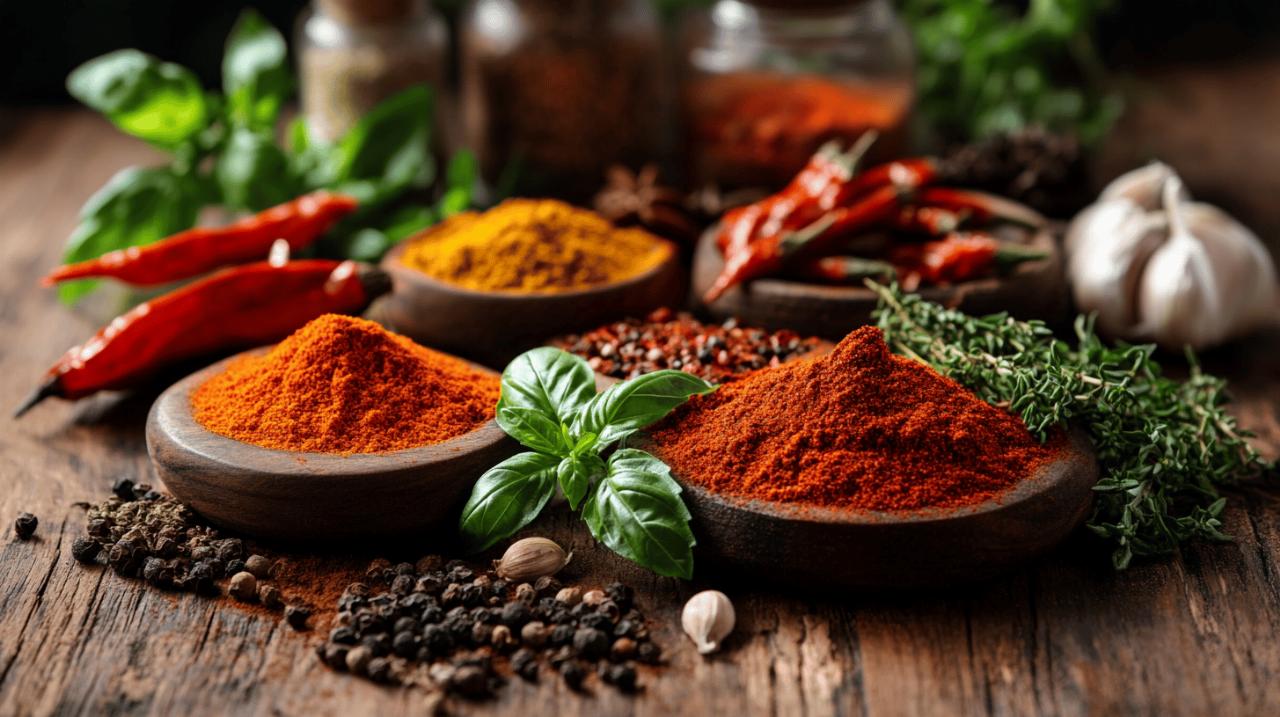Spice Cupboard Heroes: What to Replace Paprika With – Alternatives and Tips for Emergency Cooking
When you're in the midst of cooking and realise your paprika jar is empty, it can feel like a culinary emergency. Whether you're whipping up a Hungarian goulash or adding that perfect finishing touch to devilled eggs, paprika brings a distinctive character that seems irreplaceable. But fear not – your spice cupboard likely holds several heroes ready to step in and save your dish. Let's explore how to navigate this common kitchen predicament with confidence and creativity.
Understanding paprika's unique profile
Before diving into substitutes, it's worth understanding exactly what we're trying to replace. Paprika isn't just a one-note spice – it's a complex ingredient with various personalities depending on its origin and processing method. This vibrant red powder, made from ground dried red peppers, originated in Central Mexico before making its way to Spain and eventually becoming a cornerstone of Hungarian cuisine, where locals consume around half a kilogram annually.
The distinctive flavour spectrum of paprika
Paprika offers a multidimensional contribution to dishes. It provides colour (thanks to its carotene content), a range of flavours from earthy and sweet to slightly bitter, and sometimes heat. This versatility makes it a favourite in countless cuisines worldwide. When seeking replacements, we need to consider which aspects of paprika are most important for your specific recipe – is it the vibrant red hue, the earthy depth, or perhaps that subtle warmth?
Sweet, smoked and hot varieties explained
Paprika comes in three main varieties, each with distinct characteristics. Sweet paprika is mild and primarily valued for adding gorgeous colour to dishes without overwhelming heat. Hot paprika, sometimes called Hungarian paprika, brings significant spiciness along with its colour. Then there's smoked paprika (also known as Spanish paprika or pimentón), which develops its distinctive flavour from being dried over oak fires. Spanish varieties tend to be smoky and can range from mild to hot, while Hungarian paprika is generally sweeter and more versatile, available in medium or hot intensities. Understanding these differences is crucial when selecting the right substitute.
Top paprika substitutes for your kitchen
When paprika goes missing from your spice rack, several alternatives can save the day. The best choice depends on which type of paprika your recipe calls for and what aspects of it are most important to your dish.
Everyday spices that can save your dish
Chilli powder makes an excellent paprika substitute, offering a mild to moderate heat and a similar reddish tint. For smokiness similar to Spanish paprika, chipotle chilli powder works brilliantly, though it does bring more heat. Ancho chilli powder provides sweet and earthy notes comparable to sweet paprika. If heat is less important than colour, tomato powder can add both acidity and that vibrant red hue. For those seeking the colour with minimal flavour impact, a tiny pinch of saffron creates a luxurious golden-red tone. Cayenne pepper can substitute for hot paprika but should be used sparingly as it packs considerably more heat. For dishes where visual appeal matters less, other spices like cumin or coriander can provide depth, albeit with a different flavour profile.
Blending Spices for a Closer Match
Creating your own paprika substitute by blending spices often yields superior results. For sweet paprika, try combining mild chilli powder with a touch of sugar or honey to replicate its gentle sweetness. To mimic smoked paprika, add a drop of liquid smoke to regular paprika or chilli powder – but proceed with caution, as liquid smoke is quite potent. A combination of red bell pepper powder and a small amount of cayenne can approximate the colour and mild heat of basic paprika. For additional complexity, consider incorporating complementary herbs like rosemary, oregano, or cumin, which naturally enhance many dishes that traditionally call for paprika.
Choosing the Right Substitute by Dish Type
The ideal paprika alternative varies significantly depending on what you're cooking. Different dishes highlight different aspects of paprika's character, so your substitution strategy should adapt accordingly.
Best Alternatives for Stews and Soups
For hearty dishes like Hungarian goulash or Spanish stews where paprika provides foundational flavour, the replacement needs to offer depth and body. Ancho chilli powder works wonderfully in these contexts, delivering earthy complexity without overwhelming heat. A combination of mild chilli powder and smoked salt can also provide the necessary depth. For recipes where paprika primarily contributes colour to broths, tomato powder or paste adds similar visual warmth plus a touch of acidity that enhances other flavours. Remember that in slow-cooked dishes, it's often best to add these substitutes towards the end of cooking to preserve their flavour profile, just as you would with paprika.
Suitable Replacements for Dry Rubs and Marinades
When paprika features in spice rubs for meats or marinades, its role typically combines colour, flavour, and sometimes heat. For barbecue rubs where smoked paprika would normally feature, chipotle powder makes an excellent stand-in, offering both smokiness and visual appeal. For sweeter rubs, a mixture of mild chilli powder and a pinch of sugar can replicate sweet paprika's character. If your dish calls for hot paprika in a marinade, consider substitutes like Aleppo pepper powder, crushed red pepper flakes, or even a measured dash of hot sauce. These alternatives ensure your protein still gets that characteristic reddish coating and flavour infusion that paprika would normally provide.
Practical tips for emergency spice swaps
 When making last-minute substitutions, a few practical considerations can help ensure success rather than culinary disappointment.
When making last-minute substitutions, a few practical considerations can help ensure success rather than culinary disappointment.
Adjusting quantities when using alternatives
Most paprika substitutes differ in potency from the original spice, requiring careful quantity adjustments. As a general rule, start with about half the amount of cayenne pepper or hot chilli powder compared to what the recipe specifies for paprika, then adjust to taste. For milder alternatives like bell pepper powder, you might need slightly more than the called-for amount of paprika. When using liquid alternatives like hot sauce or liquid smoke, begin with just a few drops, then incrementally increase as needed. Remember that it's always easier to add more seasoning than to correct an overspiced dish.
Maintaining Colour and Visual Appeal in Your Cooking
Paprika often serves a dual purpose of flavouring and adding vibrant colour to dishes like devilled eggs, potato salad, or sprinkled atop hummus. When colour is paramount, consider using sumac for its bright red appearance and lemony flavour, or tomato powder for a deeper red. In a real pinch, a tiny amount of beetroot powder can provide striking colour, though with a different flavour profile. For garnishing purposes where paprika would typically be sprinkled on top, finely ground dried bell peppers or a light dusting of mild chilli powder can provide similar visual impact without drastically altering the dish's flavour balance.
With these versatile alternatives and practical approaches, running out of paprika need never derail your cooking plans again. Your spice cupboard likely contains several potential heroes ready to step in, ensuring your culinary creations remain delicious even when facing unexpected ingredient shortages. By understanding paprika's unique characteristics and how various substitutes can replicate them, you're well-equipped to handle this common kitchen challenge with confidence and creativity.
Regional paprika varieties and their substitutes
Right then, let's 'ave a butcher's at what you can use instead of paprika when your spice cupboard's looking a bit bare. Paprika comes in several varieties, each with unique flavour profiles from sweet to smoky to hot. Proper substitution depends on matching not just the colour, but also the taste characteristics of the specific paprika your recipe calls for.
Hungarian vs spanish paprika: finding proper replacements
Hungarian paprika tends to be sweeter and more versatile than its Spanish cousin. If you're out of Hungarian paprika, mild chilli powder makes a decent stand-in, though you might want to add a pinch of sugar to mimic that characteristic sweetness. Tomato powder also works brilliantly for sweet Hungarian paprika, providing both the lovely red colour and a bit of depth without heat.
Spanish paprika (pimentón) is distinctly smoky from being dried over oak fires. For this variety, chipotle chilli powder is your best mate – it delivers that same smoky vibe and red colour, though it does pack more heat. If you fancy the smokiness without the fire, a tiny dash of liquid smoke with regular chilli powder can do the trick. Ancho chilli powder makes another splendid substitute with its sweet, earthy character that complements many dishes requiring Spanish paprika.
Authentic Flavour Matches for Mexican and Mediterranean Dishes
For Mexican dishes calling for paprika, remember that paprika actually originated in Central Mexico before making its way to Europe. Ancho chilli powder works a treat here, with its sweet and earthy profile that's true to Mexican flavours. Red bell pepper powder offers sweetness without heat, making it spot-on for dishes where you want the pepper flavour but not the kick.
Mediterranean recipes often rely on paprika's colour and depth. When cooking these dishes, consider using a mix of cayenne pepper (used sparingly, mind) with a bit of tomato powder for acidity and colour. For paella and chorizo recipes needing smoked paprika, chipotle powder delivers the requisite smokiness, though with a bit more heat than traditional pimentón.
When substituting, always think about what role paprika plays in your dish – is it mainly for colour? Saffron could work brilliantly, adding a luxurious golden-red tint with minimal flavour change. Need the earthiness but not bothered about colour? Cumin might do the job. Storage matters too – keep your spices in sealed jars away from heat and sunlight, and they'll reward you with vibrant flavours for up to six months after opening.










